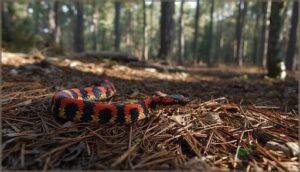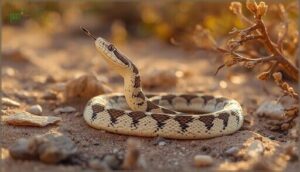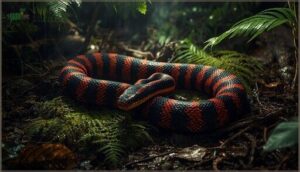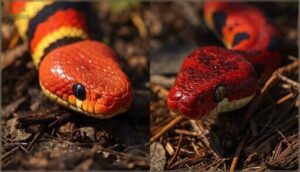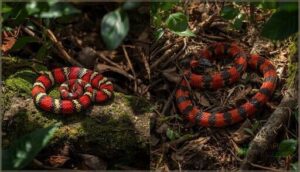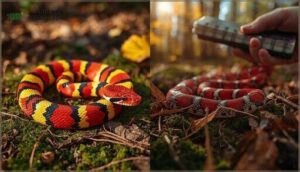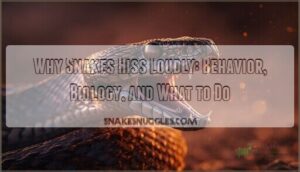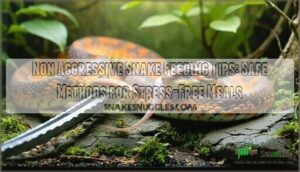This site is supported by our readers. We may earn a commission, at no cost to you, if you purchase through links.
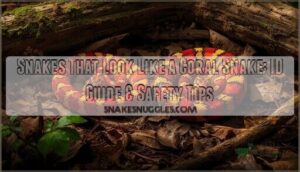
Evolution has equipped snakes that look like a coral snake with nearly identical warning colors, exploiting predators’ learned fear of venomous bites. Scarlet kingsnakes, longnose snakes, and false coral snakes all sport these deceptive patterns, but subtle differences in band arrangement, head shape, and geographic range reveal their true identities.
Understanding these distinctions isn’t just academic curiosity—it’s practical knowledge that keeps you safe during outdoor encounters while deepening your appreciation for nature’s most convincing copycats.
Table Of Contents
- Key Takeaways
- Snakes Commonly Mistaken for Coral Snakes
- Key Features of Coral Snake Mimics
- Mimicry and Its Evolutionary Role
- Habitat and Range of Coral Snake Look-Alikes
- Tips for Accurate Snake Identification
- Frequently Asked Questions (FAQs)
- What snake is mistaken for a coral snake?
- What does a false coral snake look like?
- What snake pretends to be a coral snake?
- How to tell the difference between a coral snake and a corn snake?
- How can I treat a coral snake bite?
- What time of day are coral snakes active?
- Do coral snakes have natural predators?
- What do coral snake mimics eat?
- How long do scarlet kingsnakes typically live?
- Can coral snake mimics interbreed with each other?
- Conclusion
Key Takeaways
- Several harmless snake species—including scarlet kingsnakes, scarlet snakes, and longnose snakes—have evolved to mimic the venomous coral snake’s red, yellow, and black banding through Batesian mimicry, tricking predators into avoiding them despite lacking venom.
- The “red touch yellow, kill a fellow” rhyme works for identifying eastern coral snakes in the southeastern U.S., but it’s dangerously unreliable elsewhere since 45% of harmless Central and South American species show red-touch-yellow patterns.
- True coral snakes display narrow yellow bands with red touching yellow, a black nose extending behind the eyes, and nocturnal behavior, while mimics typically show red touching black, red or speckled noses, and more active daytime behavior.
- If you encounter any banded snake in the wild, maintain at least six feet of distance, wear protective footwear in snake-prone areas, and seek immediate medical attention for any bite rather than attempting traditional first aid methods that worsen tissue damage.
Snakes Commonly Mistaken for Coral Snakes
Several harmless snake species have evolved color patterns that closely resemble the venomous coral snake’s distinctive banding. These mimics benefit from looking dangerous without actually possessing venom, which helps them avoid predators.
Let’s examine the most common species you’re likely to encounter that wear coral snake disguises.
Scarlet Kingsnakes
You’ll often encounter Scarlet Kingsnakes across the southeastern United States, where these small nonvenomous constrictors display striking red, black, and yellow bands. Their coloration exemplifies Batesian mimicry—they’ve evolved to resemble venomous coral snakes, deterring predators despite being harmless. Notice the red bands touch black, not yellow.
These secretive, fossorial snakes inhabit pine flatwoods and hardwood forests, feeding primarily on skinks and small snakes through constriction. For more information on the Scarlet Kingsnake’s southern habitat ranges, resources can be found online.
Scarlet Snakes
Scarlet Snakes (Cemophora coccinea) take coral snake mimicry in a different direction. Unlike Scarlet Kingsnakes, these fossorial specialists reach only 20 inches and sport a pointed red head—not black like true coral snakes. Their belly stays solid white or pink.
Key identification features:
- Red bands wider than black, with yellow or white separating them
- Smooth scales and slender body built for burrowing
- Prefer sandy pine forests where Habitat Loss threatens isolated populations
Their Conservation Status varies regionally, with Snake Behavior focused on hunting reptile eggs underground. Scarletsnakes are often found in areas with sandy soil conditions that support their burrowing lifestyle.
Longnose Snakes
Western longnose snakes (Rhinocheilus lecontei) showcase classic Batesian mimicry across southwestern deserts, where coral snake mimicry evolved independently. You’ll spot these harmless species by their speckled black bands—never solid like true coral snakes—and cream-flecked pointed snout.
Their tricolored pattern (sometimes lacking red entirely) reflects Snake Evolution driven by Desert Ecology, with Snake Behavior favoring sandy Longnose Habitat where these Venomous Lookalikes burrow nocturnally.
False Coral Snakes (Aniliidae)
Deep in Amazonian rainforests, false coral snakes (Anilius scytale) demonstrate textbook Batesian mimicry with 50–60 dark bands alternating across pink-to-red bodies. You’ll distinguish these fossorial burrowers by their cylindrical Snake Morphology, vestigial eyes, and cloacal spurs—anatomical fingerprints of Aniliidae Evolution absent in true coral snakes.
Their Tropical Distribution spans 831,000+ square kilometers, where nocturnal Fossorial Behavior and specialized diet (amphisbaenians, caecilians) reveal Mimicry Mechanisms refined across six independent evolutionary origins.
Key Features of Coral Snake Mimics
When you’re trying to tell a coral snake from its harmless look-alikes, a few key features can make all the difference. The details might seem subtle at first, but once you know what to look for, identification becomes much easier.
Let’s break down the most reliable physical traits that separate true coral snakes from their mimics.
Color Band Patterns
The most reliable coral snake identification method hinges on band sequence: true coral snakes display red touching yellow, while mimics usually show red touching black. This color pattern difference appears in over 98% of cases across southeastern populations.
You’ll notice genuine coral snakes feature narrow yellow rings—often just 5–8 mm wide—separating broader red and black bands that fully encircle the body, a key aspect of snake morphology supporting mimicry theory.
Head and Nose Color Differences
Beyond band sequence, head coloration offers another vital clue for coral snake identification. When examining snake head patterns and nose coloration, you’ll spot these diagnostic differences:
- True coral snakes display a black snout extending behind the eyes
- Scarlet Kingsnakes feature red or tan noses with rounded heads
- Scarlet Snakes show pointed red snouts, distinctly upturned
- Longnose Snakes exhibit speckled or mottled facial markings
- Coral snake mimics generally lack the uniform black head cap
These snout shapes and scale variations prove reliable when band patterns seem ambiguous.
Body Size and Shape
Size variation matters when you’re comparing coral snakes to their harmless mimics. Most mimic species—Scarlet Kingsnakes, Scarlet Snakes, and Longnose Snakes—stay under 51 cm (20 inches), while False Coral Snakes can reach 157 cm.
You’ll notice all these species share slender profiles with bodies about 1.27 to 2.54 cm thick, a key trait that enhances their resemblance to venomous coral snakes.
Mimicry and Its Evolutionary Role
When a harmless snake looks like a dangerous one, there’s usually an evolutionary reason behind it. This copycat strategy, called Batesian mimicry, helps nonvenomous species avoid becoming someone’s lunch by borrowing the warning colors of their toxic cousins.
Understanding how these patterns evolved—and why they work so well—gives you a clearer picture of what you’re actually looking at in the wild.
Batesian Mimicry Explained
Batesian mimicry explains why harmless snakes wear danger’s disguise. This evolutionary adaptation works because predators learn to avoid certain warning patterns—like the coral snake’s bands—after painful encounters.
When you spot a scarlet kingsnake with similar colors, you’re witnessing animal mimicry in action. The mimic benefits without producing venom, relying entirely on predator learning for survival. It’s nature’s supreme bluff, refined over countless generations.
When you see a scarlet kingsnake’s warning bands, you’re watching nature’s supreme bluff—a harmless mimic borrowing danger’s disguise through millions of years of evolution
Predator Avoidance Strategies
Mimicry effectiveness reaches 80-90% in regions where predators encounter real coral snakes regularly. Birds especially learn fast—just 1-3 exposures teach them to avoid those warning signals.
Defense mechanisms include body vibrations, tail-waving, and even false strikes. These evolutionary adaptations work because predators remember: bright bands mean danger.
That’s aposematic coloration protecting both venomous species and their harmless mimics through learned avoidance in predator-prey relationships.
Evolution of Color Patterns
You’re witnessing nature’s longest-running experiment in survival through deception. These vibrant band patterns didn’t appear overnight—they’ve evolved over roughly 16 million years through active mimicry processes and species divergence. Here’s what shaped coral snake coloration:
- Pattern Evolution shows at least 19 independent origins of Batesian mimicry across the Neotropics
- Color Genetics feature high mutation rates enabling rapid shifts between warning coloration states
- Adaptive Traits emerge and vanish frequently, especially in tropical zones
- Aposematic coloration evolved through predator learning and selective pressures
- Mimicry reversals occur when ecological constraints shift survival advantages
That’s molecular architecture driving phenotypic plasticity across millennia.
Habitat and Range of Coral Snake Look-Alikes
Understanding where these mimics live can help you figure out what you’re looking at in the wild. Each species has carved out its own niche across different regions and habitat types.
Let’s break down where you’re most likely to cross paths with coral snake look-alikes and how their ranges compare to the real deal.
Geographic Distribution
Across North America, the geographic distribution of snakes that mimic coral snakes varies considerably. Scarlet Kingsnakes are found throughout the southeastern United States, while Longnose Snakes occupy southwestern deserts.
Range overlap with true coral snakes enhances mimicry effectiveness. Regional abundance and distribution factors, such as climate, shape where these look-alikes thrive, from Florida’s pine flatwoods to Costa Rica’s tropical forests. Habitat variation influences population density.
Preferred Habitats
Understanding snake habitat preferences helps you identify which species you might encounter in your area. Scarlet Kingsnakes favor longleaf pine sandhills with dry, sandy soil composition and abundant vegetation cover—their burrowing habits keep them hidden under logs and rocks.
Scarlet Snakes prefer similar forested areas with sandy soils, while Longnose Snakes occupy arid desertscrub and grasslands.
Climate factors and habitat overlap with true coral snakes vary considerably across each species’ geographic range.
Overlapping Ranges With True Coral Snakes
Where you find coral snakes, you’ll often encounter their mimics—but the geographic overlap tells a fascinating story. Scarlet Kingsnakes share sympatric zones with Eastern Coral Snakes across the southeastern U.S., creating hotspots where Batesian mimicry thrives.
Research shows three key patterns in these overlap regions:
- Mimic abundance frequently exceeds coral snake populations by 2–6 times
- Range edges show stronger phenotypic convergence between models and mimics
- Geographic distribution varies, with lowland tropical forests displaying peak sympatry indicators and phenotypic diversity
Tips for Accurate Snake Identification
Identifying a coral snake from its harmless mimics can feel tricky when you’re face-to-face with a banded snake in the wild.
Fortunately, a few reliable techniques can help you make the right call without getting too close. Here’s what you need to know to stay safe and confident during your next snake encounter.
The “Red Touch Yellow” Rhyme
You’ve probably heard the snake identification rhyme: “Red touch yellow, kill a fellow; red touch black, friend of Jack.” While this mnemonic helps distinguish eastern coral snakes from mimics in the southeastern U.S., it’s dangerously unreliable elsewhere.
In Central and South America, 45% of harmless species show red-touch-yellow patterns, and aberrant patterns appear in 8–12% of coral snakes themselves. Don’t stake your safety on a snake color poem alone.
Distinguishing Venomous Vs. Nonvenomous Species
When you’re trying to tell coral snakes from harmless snake identification candidates like scarlet kingsnakes, color pattern variations aren’t enough—you need multiple clues. Beyond the red touch yellow rule, examine:
- Head shape analysis: Coral snakes have black noses and slender heads, while mimics often show red snouts
- Scale characteristics: Smooth scales with fixed front fangs distinguish venomous species
- Behavioral differences: True coral snakes stay hidden and nocturnal; mimics actively constrict prey during daylight
Safety Precautions and Snake Encounter Advice
When exploring snake-prone areas, your best defense combines preparation and awareness. Wear over-the-ankle boots and long pants, step on rather than over logs, and make noise while hiking to alert snakes to your presence.
| Prevention Strategy | Why It Works |
|---|---|
| Protective clothing & footwear | Blocks 60% of bites targeting ankles/feet |
| Use tools, not hands | Prevents contact with hidden snakes |
| Travel with light after dark | Reduces encounters during peak snake activity |
| Maintain safe distance (6+ feet) | Allows escape time for both parties |
If bitten despite precautions, stay calm and immobilize the affected limb—movement accelerates venom circulation. Call 911 immediately for snakebite treatment and antivenom access. Remove rings or watches before swelling begins. Never attempt traditional bite first aid like cutting, sucking, or tourniquet application, which worsen tissue damage.
For non-emergency situations involving snakes near your home, professional removal through certified snake removal services is always safer than DIY attempts. Most bites occur when people try handling snakes themselves. Investing in snake education—learning to distinguish venomous species from harmless mimics—gives you confidence during encounters while promoting coexistence. Remember, roughly 50% of venomous bites are “dry” (no venom injected), but you can’t rely on that. These snake safety tips reduce your risk substantially, turning fear into informed respect.
Frequently Asked Questions (FAQs)
What snake is mistaken for a coral snake?
Across North America, mimicry leads to misidentification rates where mimics outnumber true coral snakes 2–6 times.
You’ll most commonly confuse Scarlet Kingsnakes, Scarlet Snakes, longnose snakes, and false coral snakes with venomous coral snakes due to their similar red, black, and yellow banding patterns.
What does a false coral snake look like?
False coral snakes display bright red, orange, or pink bodies with 50 to 60 black bands, each 2 to 4 scales wide. Their cylindrical, tube-shaped bodies maintain uniform diameter throughout, with smooth, shiny scales.
What snake pretends to be a coral snake?
Several nonvenomous species engage in Batesian mimicry by imitating coral snakes’ warning coloration. Scarlet Kingsnakes are the most successful coral snake impostors, displaying vivid red, yellow, and black bands that deter predators through reptile camouflage during wild snake encounters.
How to tell the difference between a coral snake and a corn snake?
Coral snakes display red and yellow bands touching, with a black nose. Corn snakes feature red blotches on orange backgrounds without ringed patterns.
You’ll notice corn snakes are larger, non-venomous constrictors lacking the coral’s neurotoxic venom delivery system.
How can I treat a coral snake bite?
In 2009, a Florida man died from a coral snake bite after delaying care.
You can’t treat this yourself—get to a hospital immediately. Immobilize the limb, remove jewelry, and skip tourniquets or venom removal attempts.
What time of day are coral snakes active?
You’ll most often spot these venomous snakes during early morning and late afternoon hours.
Coral snakes follow diurnal patterns with crepuscular behavior at dawn and dusk, using thermal regulation to avoid midday heat through activity cycles.
Do coral snakes have natural predators?
You’d think nothing dares touch these venomous serpents, but kingsnakes and eastern indigo snakes regularly prey on coral snakes due to natural venom resistance.
Hawks and mammals also hunt juveniles opportunistically, shaping evolutionary pressures and predator-prey relationships.
What do coral snake mimics eat?
Most harmless species that display Batesian mimicry in snakes have diverse feeding habits.
Scarlet kingsnakes primarily eat skinks and small snakes, while scarlet snakes specialize in reptile eggs, and longnose snakes favor lizards.
How long do scarlet kingsnakes typically live?
In the wild, scarlet kingsnakes usually live 10 to 15 years, while captive individuals may reach 22 years under ideal conditions—demonstrating how environmental stability dramatically influences snake longevity and aging processes.
Can coral snake mimics interbreed with each other?
Different mimic species don’t interbreed, but gene flow occurs within species among populations with varying mimicry patterns. Predator-driven selection and geographic barriers maintain reproductive isolation, preventing hybridization while allowing color polymorphism in snakes to persist.
Conclusion
When push comes to shove, distinguishing snakes that look like a coral snake from the real deal boils down to observation and caution. You’ve learned the band patterns, geographic ranges, and behavioral clues that separate harmless mimics from venomous species.
Don’t let uncertainty cloud your judgment—maintain a respectful distance, verify visual markers, and consult local herpetological resources when needed. Armed with this knowledge, you’ll navigate encounters confidently while appreciating evolution’s most striking visual deceptions.
- https://www.pnas.org/doi/10.1073/pnas.2318857121
- https://sararuane.com/wp-content/uploads/2022/01/sena_and_ruane2022.pdf
- https://www.nature.com/articles/ncomms11484
- https://pmc.ncbi.nlm.nih.gov/articles/PMC4858746/
- https://www.davidpfenniglab.com/wp-content/uploads/2019/10/2010_Am_Nat_KikuchiPfennig.pdf

